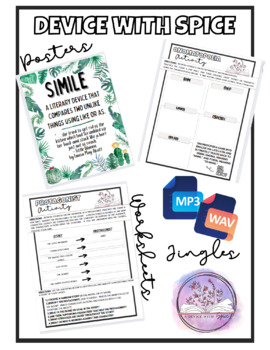Device with Spice! (Literary Devices and Elements)
- Zip
What educators are saying
Description
Device with Spice: Let's make learning the literary devices fun!
Installment One: The literary elements and devices - oxymoron, simile, metaphor, personification, onomatopoeia, protagonist, antagonist, alliteration, and repetition - are taught with extremely catchy jingles that are designed to catch the attention of students at any age and stick in their memories for a lifetime! Included with the jingles are fun worksheets to reinforce student learning. Posters can be printed with four options of themes and two different sizes (5X7 and 8X10). Finally, book club instructions and booklists are used to truly reinforce student learning! Your students will love you for presenting the devices in such an entertaining way!
Product includes jingles, worksheets, posters, and instructions for:
- Literary Elements
- Oxymoron
- Simile
- Metaphor
- Personification
- Onomatopoeia
- Protagonist
- Antagonist
- Alliteration
- Repetition


